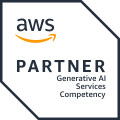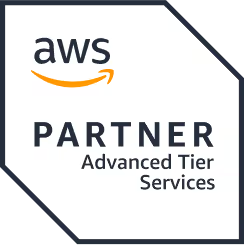Building Resilient AI Teams: Lessons in Ownership, Exposure, and Challenge
TL'DR
- In AI delivery environments, team structure determines outcomes. The most effective AI organizations align around ownership, technical challenges, and feedback loops. This blog outlines five principles for engineering leaders building teams that perform under uncertainty and scale with intent.
Why AI Team Design Is Now a Strategic Priority
AI is changing how products are built. While tools evolve rapidly, team design is often the bottleneck. As systems become more complex, with generative models, agent architectures, and multi-modal stacks, adaptability in team structures becomes a first-order design variable.
McKinsey’s AI report found that 40% of organizations expect to increase investment in AI due to GenAI's impact showing how deeply strategy and team structure must evolve in parallel.
Engineering leaders must design teams that can move decisively, learn in short cycles, and handle ambiguity without breakdown. Here is how.
1. Hire for Applied Intelligence
Start with talent that thrives in uncertain environments. Technical depth is necessary. But execution under ambiguity depends on:
- Engineers who reason across architecture, infrastructure, and interface
- Product thinkers fluent in both user workflows and system constraints
- Communicators who clarify intent, not just implement code
Harvard Business Review notes that teams with “learning agility” and context-switching abilities outperform those optimized purely for specialization.
Hiring criteria should reflect system complexity.
Want a tactical ramp-up path? See AI Engineer Roadmap for how engineers transform into AI-ready roles.
2. Operationalize Ownership
Resilient teams operate with control over scope and decision rights. That requires:
- Defined boundary conditions
- Clear escalation protocols
- Senior leaders who unblock without micromanaging
Giving ownership also increases retention. A Deloitte study found that employees who feel empowered are 67% more likely to stay beyond three years.
Align incentives structurally. Equity-linked models or outcome KPIs move contributors from task execution to system thinking.
At Ideas2IT, we've embedded this structurally. With 33% of the company employee-owned, teams don’t just participate they lead. That translates directly to outcomes our clients notice.
3. Engineer Challenge into the Operating Model
Technical maturity grows under high-agency environments. Teams engage better when aligned around problems worth solving:
- Can we deploy this LLM on-device with latency below 50ms?
- Can we build real-time explainability without throughput degradation?
- Can we support agent behaviour within existing compute budgets?
Use structural separation:
- Production track focused on deliverables and metrics
- Exploration track free to experiment without production debt
This balance preserves delivery while enabling innovation.
This duality mirrors our approach in AI in Software Development: stable SDLC flows for delivery, and parallel tracks for AI-embedded transformation.
4. Broadcast Execution, Not Effort
Recognition matters when it is tied to outcomes. Internal visibility into technical accomplishments drives momentum and system-wide calibration.
Tactical options:
- Demo forums
- Engineering retros with real postmortems
- Cross-team teardown sessions
A report by BCG highlights that high-maturity AI teams regularly share outcomes in open formats, improving accountability and fostering the reuse of solutions.
Highlight execution. Attribute results.
5. Build Learning into Team Mechanics
What worked last sprint may already be out of date. Teams need:
- Weekly reviews of systems research and conference papers
- Architecture debates with rotating ownership
- Input from external benchmarks such as CVPR, ML Systems, and ICLR.
Prioritize sharp internal critique over passive trend tracking. Good judgment compounds.
How Ideas2IT Is Prepping for the AI Game
We’ve adopted AI across the company not as a service line, but as a principle. As the AI landscape transforms rapidly with Generative AI, Agentic AI, and Edge-native systems, we’ve embedded readiness into our culture, tooling, and team design.
Company-Wide AI Adoption Strategy
- Cross-Functional AI Squads: Our teams are structured to include engineering, design, and product leads using Gen AI tools across SDLC, QA, and customer workflows.
- End-to-End AI Integration: AI is now embedded into how we code, test, deploy, and monitor applications supported by our internal accelerators and prompt engineering libraries.
Ideas2IT doesn’t just talk about AI. We build, test, and teach with it across every function. Here's how we're creating an AI-native operating enterprise through real internal initiatives:
1. AI in QA Meetup Hosting
Hosted the BrowserStack AI in QA Meetup with leaders from Verizon and Saama. Our engineers showcased live use cases in behavior detection and regression automation.
→ LinkedIn Post
2. 24-Hour Design-to-Delivery AI Challenge
An internal initiative where a designer built a complete ticketing app using AI tools like Lovable and Cursor within 24 hours demonstrating how AI can power vertical-first thinking.
→ LinkedIn Post
3. Agentic AI + n8n Workshop
150+ attendees joined our workshop on orchestrating autonomous workflows. The format included live demos and a custom storytelling website.
→ LinkedIn Post
4. Live Coding with Cursor
We hosted 50+ developers in a hands-on coding event where a full website was built live in front of the audience using AI dev tools.
→ LinkedIn Post
5. Open Knowledge Culture
Every one of these events is part of a broader push toward open knowledge sharing at Ideas2IT. Our engineers don’t just learn. They contribute, teach, and publish. Whether it’s speaking at panels, writing blogs, or running internal learning pods, we’re creating a culture that keeps pace with AI’s velocity.
6. Upskilling at scale
500+ engineers trained in GenAI, TinyML, and edge inference . Weekly ongoing challenges focused on compression, prompt tuning, and retrieval quality is conducted dedicatedly.
AI teams succeed when the environment is engineered not improvised. That means:
- Role clarity paired with decision rights
- Technical challenge as a cultural asset
- Visibility baked into execution
- Learning treated as a first-class system
- Platform-level thinking behind every team
Set ownership boundaries. Pose hard problems. Reward impact. Build mechanisms for continual adjustment.
To see how we build high-performance AI teams inside enterprise environments, talk to us.







.png)
.png)
.png)
.png)
.png)
.png)












